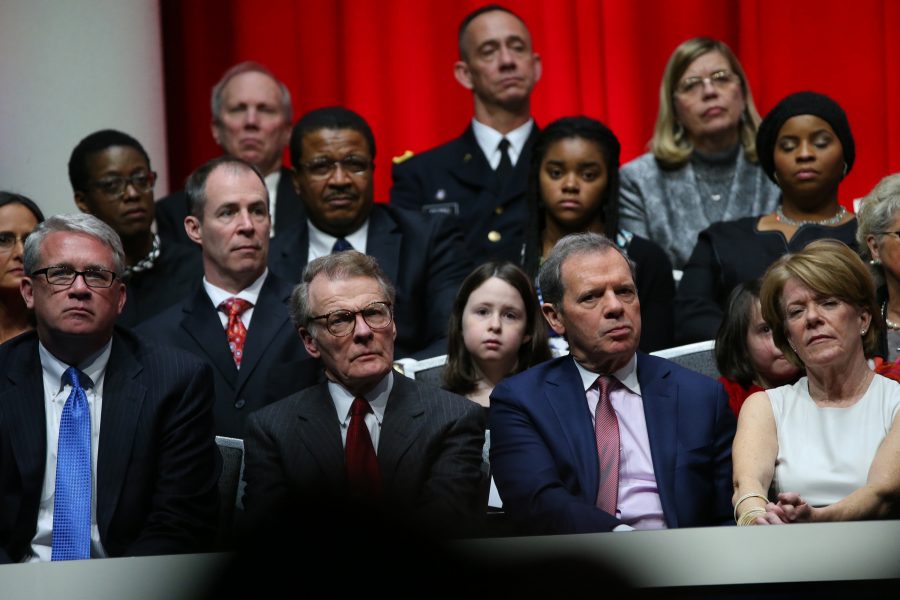State makes first school funding payments
Speaker Mike Madigan and Senate President John Cullerton listen as Gov. Bruce Rauner speaks about making changes in the state on Monday Jan. 12, 2015 at the Prairie Capital Convention Center in Springfield, Ill. (Nancy Stone/Chicago Tribune/TNS)
September 7, 2017
After months — and some might argue years — of uncertainty, schools began receiving notice that payments were on the way Thursday, following approval of a funding formula by the General Assembly.
Just after midnight Thursday morning, Comptroller Susana Mendoza’s said her office began delivering $541 million in general state aid to schools around the state. These were supposed to go out on Aug. 10 and 20, but were delayed as Gov. Bruce Rauner and legislative leaders haggled over a compromise school funding bill, following Rauner’s amendatory veto of Senate Bill 1.
The next payment of $264 million will go out Friday to cover the first September payment due Sunday, Sept. 10, bringing the total to $805 million for school coffers.
Advertisement
Districts have received notice that the money is on the way but have not yet received any, said Decatur schools’ Chief Operational Officer, Todd Covault, and the funds that are coming are based on last year’s formula, not the new one.
“The evidence-based formula has not yet been calculated,” Covault said. “The Illinois State Board of Education will continue to use last year’s funding calculation as a base model. Today, (Decatur public schools) received notification that the first two payments totaling $4,238,170 have been vouchered to the comptroller. The district anticipates receiving the funds no later than Friday.
“In the meantime, ISBE will calculate the new funding formula and anticipates this may take up to two months. Once this has been calculated, the district anticipates receiving additional funds above what was appropriated last year.”
While waiting for legislators to approve a funding formula, and anticipating the need to fall back on cash reserves to keep operating, Covault said, the district had most of its cash in “idle investments,” so that funds would be readily available if necessary. Now that state aid payments have been authorized, his office is studying investments that will bring longer-term gains.
Funding of any kind for schools was tied up in the legislative give-and-take of the state’s first budget in three years. The budget passed by lawmakers over Rauner’s veto required a new funding-based formula be approved before money could be released. It took continued negotiations before a bill was finally passed on Aug. 29 and signed by Rauner on Aug. 31.
Meridian Superintendent Dan Brue said his district is happy to receive the funding but still figuring out precisely how much it will receive.
“When we get state funding, that is a big deal. We are really excited about it,” he said.
Advertisement*
The payments are about a month late to the school district which typically receives state money at the beginning and middle of August. In the short term, this hasn’t affected the start of the school year, Brue said.
“But for the long term, it definitely relieves a lot of burden for us,” he said.
Central Illinois superintendents said earlier in the summer that they worried about reserves holding out without state funds. Brue estimated that Meridian would run out of money in January, and Covault said the district would run out by November. Central A&M Superintendent DeAnn Heck had said her district could just get through the school year, but called the situation “frightening” and “surrealistic.”
Districts’ choices were limited and unattractive, ranging from borrowing against next year’s taxes to asking teachers to work for IOUs. Even if districts had attempted to issue bonds, essentially borrow funds, with all the state’s districts in similar dire straits, it was considered likely lenders would have demanded high interest rates.
Either way, superintendents noted such borrowing would have only pushed the burden farther along the calendar, affecting budgets for the next school year at the expense of keeping doors open this year.
Besides distributing state aid more equitably, the long-sought deal the legislature approved gives districts more flexibility on state mandates, allows residents in well-funded districts to reduce their property taxes and creates a new tax credit for donations to private school scholarships.
It also provides more than $430 million in new funding to Chicago Public Schools. That’s roughly $150 million more than the amount Rauner stripped from an earlier plan and railed against as a “bailout.”
___
(c)2017 the Herald & Review (Decatur, Ill.)
Visit the Herald & Review (Decatur, Ill.) at www.herald-review.com
Distributed by Tribune Content Agency, LLC.
Advertisement









